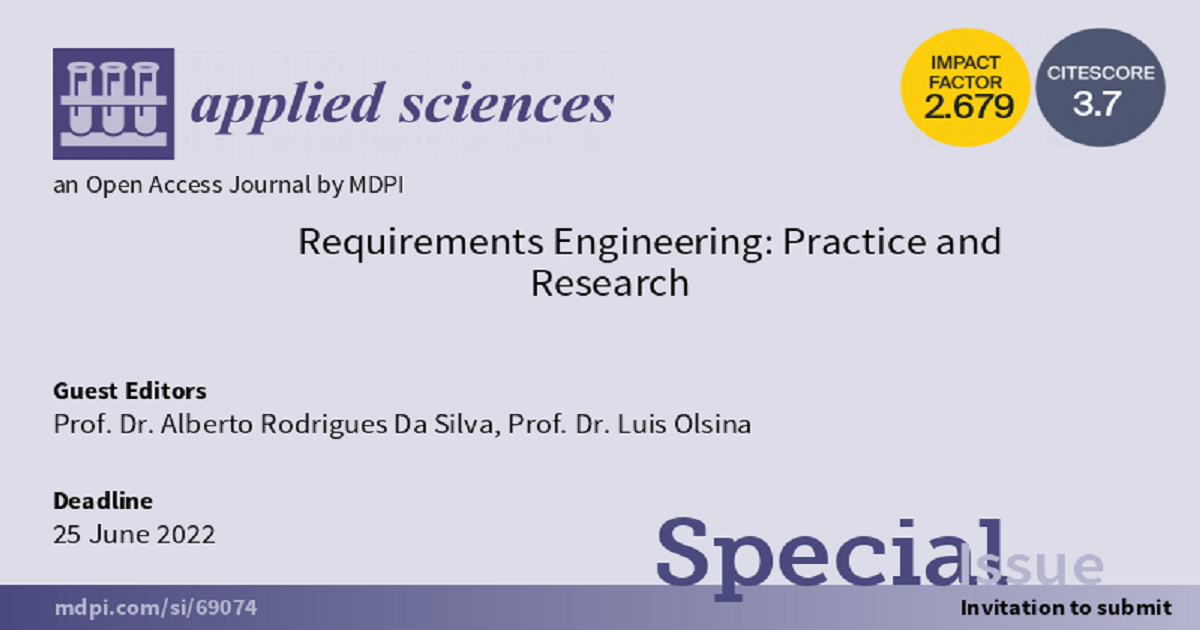- 2.5Impact Factor
- 5.5CiteScore
- 20 daysTime to First Decision
Requirements Engineering: Practice and Research
This special issue belongs to the section “Computing and Artificial Intelligence“.
Special Issue Information
Dear Colleagues,
With recent developments in cloud and mobile computing technologies, the growing need for secure, trustworthy, and cost-efficient software and the shortage of highly skilled professional software developers have given rise to a new generation of problems that require improved forms of specifying and representing such systems at multiple abstraction levels and with multiple concerns and stakeholder perspectives.
Requirements engineering (RE) is a multidisciplinary and human-centered process that is integrated with both systems engineering and software engineering and provides a shared vision and understanding of complex systems throughout their life-cycles.
RE involves disparate activities such as eliciting, analyzing, defining, documenting, validating, and managing requirements. The negative consequences of ignoring these early RE activities are extensively reported and discussed in the literature.
RE needs to be sensitive to how people perceive and understand the world around them, how they interact, how they interact with their systems, and how the sociology of the organizations affects their actions. Thus, RE draws on the cognitive and social sciences to provide both theoretical grounding and practical techniques for eliciting and specifying requirements, including a diversity of areas such as computer science, software engineering, cognitive psychology, anthropology, sociology, and linguistics.
The objectives of the Special Issue are to:
- Bring together researchers and practitioners from the RE and related communities;
- Explore the technologies that power contemporary RE tools and platforms;
- Discuss the emerging problems and open challenges identified by the RE community;
- Share case studies and empirical studies of applying RE tools and best practices;
- Discuss textual and visual domain-specific languages;
- Discuss aspects of RE for emerging specific domains.
Topics of interest for the special issue include but are not limited to:
- RE textual specification languages;
- RE visual and modeling languages;
- RE for specific domains, such as cyber-physical systems, big data, or AI applications;
- Automatic analysis of requirement specifications;
- RE and natural language processing (NLP) techniques;
- Software tools and platforms for RE;
- RE quality;
- RE and software testing;
- RE and document automation techniques;
- RE for privacy, security, and safety aspects.
Prof. Dr. Alberto Rodrigues Da Silva
Prof. Dr. Luis Olsina
Guest Editors
Manuscript Submission Information
Manuscripts should be submitted online at www.mdpi.com by registering and logging in to this website. Once you are registered, click here to go to the submission form. Manuscripts can be submitted until the deadline. All submissions that pass pre-check are peer-reviewed. Accepted papers will be published continuously in the journal (as soon as accepted) and will be listed together on the special issue website. Research articles, review articles as well as short communications are invited. For planned papers, a title and short abstract (about 250 words) can be sent to the Editorial Office for assessment.
Submitted manuscripts should not have been published previously, nor be under consideration for publication elsewhere (except conference proceedings papers). All manuscripts are thoroughly refereed through a single-blind peer-review process. A guide for authors and other relevant information for submission of manuscripts is available on the Instructions for Authors page. Applied Sciences is an international peer-reviewed open access semimonthly journal published by MDPI.
Please visit the Instructions for Authors page before submitting a manuscript. The Article Processing Charge (APC) for publication in this open access journal is 2400 CHF (Swiss Francs). Submitted papers should be well formatted and use good English. Authors may use MDPI's English editing service prior to publication or during author revisions.

Benefits of Publishing in a Special Issue
- Ease of navigation: Grouping papers by topic helps scholars navigate broad scope journals more efficiently.
- Greater discoverability: Special Issues support the reach and impact of scientific research. Articles in Special Issues are more discoverable and cited more frequently.
- Expansion of research network: Special Issues facilitate connections among authors, fostering scientific collaborations.
- External promotion: Articles in Special Issues are often promoted through the journal's social media, increasing their visibility.
- e-Book format: Special Issues with more than 10 articles can be published as dedicated e-books, ensuring wide and rapid dissemination.

